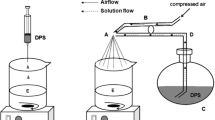Abstract
A novel oral multiple-unit dosage form which overcame many of the problems commonly observed during the compression of microparticles into tablets was developed in this study. Micro- or nano-particles were entrapped in beads formed by ionotropic gelation of the charged polysaccharide, chitosan or sodium alginate, in solutions of the counterion, tripolyphosphate (TPP) or calcium chloride (CaCl2), respectively. The described technique did not change the physical properties of the microparticles, and it allowed a high microparticle loading (up to 98%). The ionic character of the polymers allowed pH-dependent release of the microparticles. Chitosan beads disintegrated and released the microparticles in 0.1 N HC1, while calcium alginate beads stayed intact in 0.1 N HC1 but rapidly disintegrated in simulated intestinal fluids. Coating the calcium alginate beads with cellulose acetate phthalate resulted in an enteric drug delivery system. Scanning electron microscopy and dissolution and disintegration tests were used to characterize the microparticle-containing beads. The disintegration time of the beads was studied as a function of the solution viscosity of the polysaccharide, gelation time, counterion concentration, and method of drying.
Similar content being viewed by others
REFERENCES
P. B. Deasy. Microencapsulation and Related Drug Processes, Marcel Dekker, New York, 1984.
A. Kondo. Microcapsule Processing and Technology, Marcel Dekker, New York, 1979.
J. Sjoegren. In L. F. Prescott and W. S. Nimmoe (eds.), Rate Control in Drug Therapy, Churchill Livingstone, Edinburgh, 1985, pp. 38–47.
S. Y. Lin. J. Pharm. Sci. 77:229–232 (1988).
A. R. Fassihi. Int. J. Pharm. 44:249–256 (1988).
I. Jalsenjak, C. F. Nicolaidou, and J. R. Nixon. J. Pharm. Pharmacol. 29:169–172 (1977).
F. Lim. In F. Lim (ed.), Biomedical Applications of Microencapsulation, CRC Press, Boca Raton, Fla., 1984, pp. 137–154.
Y. Pramar and R. Bodmeier. Abstracts of the 47th International Congress of Pharmaceutical Sciences of F.I.P., Amsterdam, The Netherlands, 1987, p. 116.
R. Bodmeier and J. W. McGinity. Pharm. Res. 4:465–471 (1987).
J. Kreuter. In K. J. Widder and R. Green (eds.), Drug and Enzyme Targeting, Academic Press, Orlando, Fla., 1985, pp. 129–138.
R. Gurny, N. A. Peppas, D. D. Harrington, and G. S. Banker. Drug Dev. Ind. Pharm. 7:1–25 (1981).
C. Damge, C. Michel, M. Abrahamian, P. Couvreur, and F. Puisieux. Abstracts of the International F. I. P. Satellite Symposium, Leiden, The Netherlands, 1987, p. 10.
R. W. Korsmeyer and N. A. Peppas. J. Membr. Sci. 9:211–227 (1981).
R. Kohn. Pure Appl. Chem. 42:371–397 (1975).
C. J. Malm, J. Emerson, and G. D. Hiatt. J. Am. Pharm. Assoc. 40:520–515 (1951).
Author information
Authors and Affiliations
Rights and permissions
About this article
Cite this article
Bodmeier, R., Chen, H. & Paeratakul, O. A Novel Approach to the Oral Delivery of Micro- or Nanoparticles. Pharm Res 6, 413–417 (1989). https://doi.org/10.1023/A:1015987516796
Issue Date:
DOI: https://doi.org/10.1023/A:1015987516796




